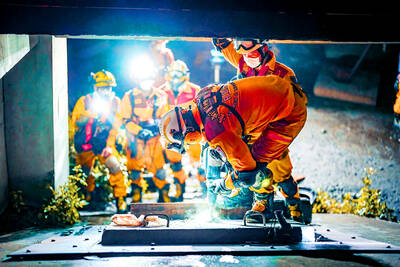Training with drones would become necessary, and drone training would be included alongside precision missile drills conducted by different military units, a source said on Saturday.
As various units continue to receive drones, joint operations training integrating uncrewed platforms with land, sea and air forces would become necessary, the source said, adding that such training might even be a part of this year’s Han Kuang live-fire exercises.
To counter ongoing intimidation by the Chinese People’s Liberation Army, the military has been acquiring various categories of armaments, including those that could bolster asymmetric warfare capabilities and defense resilience, they said, adding that drones form part of those efforts.

Photo: Daniel Ceng, AP
Former US Indo-Pacific commander Admiral John Aquilino introduced the idea of using drones to defend Taiwan in what he coined the “hellscape” strategy in August 2023.
The strategy is an asymmetric warfare concept that involves deploying thousands of low-cost uncrewed drones, ships and submarines in large numbers to delay or even destroy enemy forces in a storm-like swarm attack. US Indo-Pacific Commander Admiral Samuel Paparo has since reaffirmed the concept in an interview in June last year.
However, a significant effort would be required to reach the capabilities needed to implement such a strategy, the sources said.
“Although the military has demonstrated drone capabilities in major exercises such as the Han Kuang military drills and has closely monitored Chinese warships, drone operations have mostly been limited to reconnaissance missions involving single units,” they said.
Integrating drones into joint combat operations or live-fire exercises is a complex and risky endeavor, and Taiwan has very few designated sea and air training zones, necessitating careful planning and further discussions before engaging in such exercises, they said.
Understanding how uncrewed platforms integrate with other military equipment requires further research, Democratic Progressive Party Legislator Puma Shen (沈伯洋) said.
While there is no complete plan for uncrewed surface vessels yet, the integration of drones with land, sea and air forces, along with drone logistics and live-fire testing, must be strengthened, he said, adding that the military should look at incorporating civilian drones into military operations.
“Also, joint training with drones should aim to enhance overall combat effectiveness. Merely testing drones’ range and visual targeting capabilities during drills would be meaningless,” said Shen, who is cochair of the legislative Foreign and National Defense Committee.
Shu Hsiao-huang (舒孝煌), a researcher at the government-funded think tank Institute for National Defense and Security Research, agreed with the need to incorporate drone training into military drills.
“Only through precision live-fire exercises and the Han Kuang drills can Taiwan validate the reliability of the military technologies it is developing, and the effectiveness of its combat concepts,” he said.
Commenting on how drones could improve combat capabilities, Shu cited the example of the M142 HIMARS multiple rocket launcher system, which arrived in Taiwan in October last year, but was absent from last year’s Han Kuang exercises.
Given the HIMARS’ extended range beyond traditional visual targeting, drones are essential for target acquisition when using the system, he said.
As for advancing the hellscape strategy, Shu said that the key lies in reducing costs and adopting the mindset of treating suicide drones as expendable munitions.
Future attack drone strategies should leverage AI technology to enhance coordination and mission allocation of drones, he said.
The Chungshan Institute of Science and Technology is heading in the right direction with its research into such technologies, he said.
“Once the navy establishes its littoral combat command, it should consider acquiring uncrewed platforms to serve as supplementary firepower,” he said.

Weather conditions across Taiwan are expected to remain stable today, but cloudy to rainy skies are expected from tomorrow onward due to increasing moisture in the atmosphere, according to the Central Weather Administration (CWA). Daytime highs today are expected to hit 25-27°C in western Taiwan and 22-24°C in the eastern counties of Yilan, Hualien, and Taitung, data on the CWA website indicated. After sunset, temperatures could drop to 16-17°C in most parts of Taiwan. For tomorrow, precipitation is likely in northern Taiwan as a cloud system moves in from China. Daytime temperatures are expected to hover around 25°C, the CWA said. Starting Monday, areas

A Taiwanese software developer has created a generative artificial intelligence (AI) model to help people use AI without exposing sensitive data, project head Huang Chung-hsiao (黃崇校) said yesterday. Huang, a 55-year-old coder leading a US-based team, said that concerns over data privacy and security in popular generative AIs such as ChatGPT and DeepSeek motivated him to develop a personal AI assistant named “Mei.” One of the biggest security flaws with cloud-based algorithms is that users are required to hand over personal information to access the service, giving developers the opportunity to mine user data, he said. For this reason, many government agencies and

The National Fire Agency on Thursday said a series of drills simulating a magnitude 8.5 earthquake would be held in September to enhance the government’s emergency response capabilities. Since earthquakes cannot be predicted, only by continuously promoting disaster prevention measures could Taiwan enhance its resilience to earthquakes, agency Director-General Hsiao Huan-chang (蕭煥章) said in a news release. The exercises would be held to mark annual National Disaster Prevention Day on Sept. 21, the aim of which is to test Taiwan’s preparedness and improve its earthquake resilience in case of a major temblor, Hsiao said. As part of those drills, an earthquake alert would

STRICTER ENFORCEMENT: Taipei authorities warned against drunk cycling after a sharp rise in riding under the influence, urging greater public awareness of its illegality Taipei authorities have issued a public warning urging people not to ride bicycles after consuming alcohol, following a sharp rise in riding under the influence (DUI) cases involving bicycles. Five hundred and seven people were charged with DUI last year while riding YouBikes, personal bicycles, or other self-propelled two-wheelers — a fourfold increase from the previous year, data released by the Taipei Police Department’s Traffic Division showed. Of these, 33 cases were considered severe enough to be prosecuted under “offenses against public safety,” the data showed. Under the Road Traffic Management and Penalty Act (道路交通管理處罰條例), bicycles — including YouBikes and other